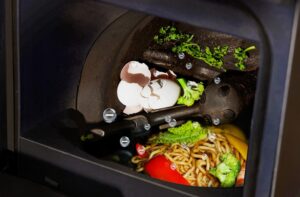
A nerve cell (stained green) growing among a cancer cell culture
Simon Grelet and Gustavo Ayala
Cancer cells steal energy-generating parts from nerve cells to fuel their spread to distant sites, a discovery that could improve treatments against the deadliest tumours.
“This is the first time that mitochondrial exchange has been demonstrated from nerves to cancer cells,” says Elizabeth Repasky at the Roswell Park Comprehensive Cancer Center in Buffalo, New York, who wasn’t involved in the research. “It’s a major next step in cancer neuroscience, a field that’s exploding.”
We already knew that nerve cells, or neurons, within and surrounding tumours produce proteins and electrical signals that help cancer grow and spread. “Cancers with higher nerve density are associated with poorer prognosis,” says Simon Grelet at the University of South Alabama.
Prior studies have also shown that brain cancer cells can acquire mitochondria – energy-generating structures – from non-neuronal brain cells. But it was unknown whether tumour cells could take mitochondria from nerve cells, says Grelet.
To find out, he and his colleagues genetically engineered breast cancer cells from mice to contain a red fluorescent molecule and mixed them with mouse nerve cells, containing mitochondria labelled with green pigment, in a lab dish. By imaging the cells, they found that cancer cells stole mitochondria from the nerve cells within a few hours.
“The cancer cells elongate their membrane so they are stealing, siphoning, the mitochondria from the neurons,” says Grelet. “It’s like a train of mitochondria that pass through a very tiny structure, entering the cancer cell one at a time,” he says.
To see if this occurs in the body, the researchers injected red breast cancer cells into the nipples of female mice to form tumours. They also genetically engineered the nerves around the tumours to carry green mitochondria. Around a month later, 2 per cent of the cancer cells in these tumours had acquired mitochondria from neurons.
In contrast, 14 per cent of tumour cells that had spread to the brain carried nerve-derived mitochondria – suggesting that cancer cells with nerve-derived mitochondria were much better at spreading than those without. Further experiments suggest this is because cells with stolen mitochondria are better at enduring physical and chemical stresses that they encounter in the bloodstream.
“There are many, many obstacles for a cancer cell that’s trying to spread,” says Repasky. “They have to break out of the initial tumour, make it through barriers of the blood vessels, get out of the blood, then get enough oxygen and nutrients at the secondary site – most of them don’t make it,” she says. “Stealing mitochondria seems to allow cancer cells to better endure that obstacle course,” she says.
To explore if this happens in people, the researchers analysed tumour samples from eight women with breast cancer that had spread to distant sites within their bodies. They found that tumour cells from other parts of the body had 17 per cent more mitochondria, on average, compared with those in the breast, suggesting the process does occur in patients, says Grelet.
What’s more, the team analysed a human prostate tumour sample and found that cancer cells closer to nerves contained substantially more mitochondria than those further away. “We think it would be a universal mechanism that all sorts of tumours will be doing,” says team member Gustavo Ayala at the University of Texas Health Sciences Center at Houston.
The findings suggest that blocking mitochondrial transfer could reduce the spread of the deadliest tumours. “I do believe this will be possible, at least in certain kinds of tumours,” says Repasky. Ayala says the researchers plan to develop drugs that can do this.
Topics:









